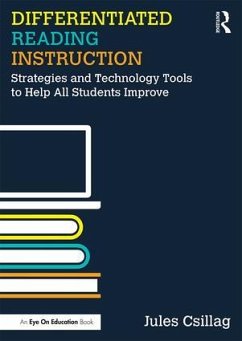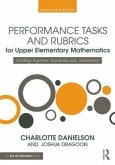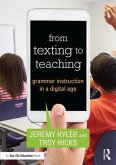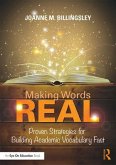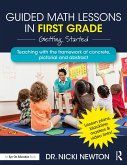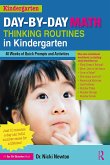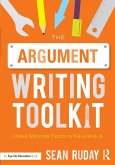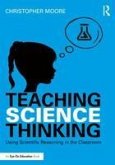Jules Csillag
Differentiated Reading Instruction
Strategies and Technology Tools to Help All Students Improve
Jules Csillag
Differentiated Reading Instruction
Strategies and Technology Tools to Help All Students Improve
- Broschiertes Buch
- Merkliste
- Auf die Merkliste
- Bewerten Bewerten
- Teilen
- Produkt teilen
- Produkterinnerung
- Produkterinnerung
This practical guide brings together evidence-based principles for differentiated reading instruction and user-friendly tech tools, to help middle level students grow as readers in fun, interactive, and engaging ways.
Andere Kunden interessierten sich auch für
![Performance Tasks and Rubrics for Upper Elementary Mathematics Performance Tasks and Rubrics for Upper Elementary Mathematics]() Charlotte DanielsonPerformance Tasks and Rubrics for Upper Elementary Mathematics46,99 €
Charlotte DanielsonPerformance Tasks and Rubrics for Upper Elementary Mathematics46,99 €![From Texting to Teaching From Texting to Teaching]() Jeremy HylerFrom Texting to Teaching40,99 €
Jeremy HylerFrom Texting to Teaching40,99 €![Making Words Real Making Words Real]() Joanne BillingsleyMaking Words Real47,99 €
Joanne BillingsleyMaking Words Real47,99 €![Guided Math Lessons in First Grade Guided Math Lessons in First Grade]() Nicki NewtonGuided Math Lessons in First Grade36,99 €
Nicki NewtonGuided Math Lessons in First Grade36,99 €![Day-by-Day Math Thinking Routines in Kindergarten Day-by-Day Math Thinking Routines in Kindergarten]() Nicki NewtonDay-by-Day Math Thinking Routines in Kindergarten35,99 €
Nicki NewtonDay-by-Day Math Thinking Routines in Kindergarten35,99 €![The Argument Writing Toolkit The Argument Writing Toolkit]() Sean RudayThe Argument Writing Toolkit35,99 €
Sean RudayThe Argument Writing Toolkit35,99 €![Teaching Science Thinking Teaching Science Thinking]() Christopher MooreTeaching Science Thinking41,99 €
Christopher MooreTeaching Science Thinking41,99 €-
-
-
This practical guide brings together evidence-based principles for differentiated reading instruction and user-friendly tech tools, to help middle level students grow as readers in fun, interactive, and engaging ways.
Hinweis: Dieser Artikel kann nur an eine deutsche Lieferadresse ausgeliefert werden.
Hinweis: Dieser Artikel kann nur an eine deutsche Lieferadresse ausgeliefert werden.
Produktdetails
- Produktdetails
- Verlag: Taylor & Francis
- Seitenzahl: 170
- Erscheinungstermin: 10. Mai 2016
- Englisch
- Abmessung: 244mm x 173mm x 13mm
- Gewicht: 318g
- ISBN-13: 9781138641228
- ISBN-10: 1138641227
- Artikelnr.: 45064647
- Verlag: Taylor & Francis
- Seitenzahl: 170
- Erscheinungstermin: 10. Mai 2016
- Englisch
- Abmessung: 244mm x 173mm x 13mm
- Gewicht: 318g
- ISBN-13: 9781138641228
- ISBN-10: 1138641227
- Artikelnr.: 45064647
Jules Csillag is a licensed speech-language pathologist, learning specialist, and a teacher of students with speech and language disabilities. She has presented at conferences such as ISTE, LDA, ILA, ASHA, and the Everyone Reading Conference.
Meet the Author
Introduction: What is Reading, and How Can I Help?
1. What is reading?
* From Decoding to Higher Level Thinking, and Everything in Between
* Language Comprehension and Reading Comprehension
* Reading and the Brain
2. Teachers' Changing Roles
3. How Technology and Reading are an Ideal Match
4. How to Use this Book
5. A Note about the Technology in this Book
Chapter 1: What Do You Mean by "Differentiation"?
6. Long Ago and Far Away, the Greeks Warned Us
7. Differentiation vs Tracking
8. Types of Differentiation
* Differentiation by Interest
* Differentiation by "Learning Style"
* Differentiation by Readiness
9. Universal Design for Learning (UDL) and Differentiation: Two Sides of the
Same Coin
* Differentiation by UDL Categories
* Group Names, Group Members, and Group Selection
10. Differentiation and the Law
11. Frameworks for Differentiation
12. Reflection
Chapter 2: What Do Your Students Know? Formative Assessments for
Differentiation
13. Growth Mindset
14. How it Works and How Technology can Help
15. Formative Assessment via Forms & Quizzes
* Google Forms and Sheets
* Other Options for Collecting Formative Assessments via Forms &
Quizzes (LMS & more)
16. Formative Assessment via Audio and Video Recordings
* Create a Screen recording, Voice recording, and/or Video recording
17. Formative Assessment via Sorting Activities
18. Reflection
Chapter 3: What Does This Say? Differentiating for Decoding and Reading
Fluency
19. Why Decoding and Fluency Matter
20. What to Expect: Typical Decoding and Fluency Development
21. With Great Power Comes Great Responsibility
22. How Technology Can Help (and How it Can't)
23. Text-to-Speech Tools
* Built-in Tools
* Text-to-Speech Tools with Additional Features
* Turning Images into Text: Optical Character Recognition (OCR)
* Podcasts for Some, or Podcasts for All
* eBooks & Audiobooks
* Closed Captioning for Videos
24. Providing Audio Instructions and Feedback for Students
25. Student-Generated Voice and Audio Recordings to Enhance Fluency
26. Reflection
Chapter 4: What Does This Mean? Part 1: Differentiating Vocabulary
Instruction
* Two approaches to Instruction: Direct and Contextual
* Tools for Direct Instruction
* Tools for Contextual Instruction
* Tools that can be used for either approach (& how)
* Reflection
Chapter 5: What Does This Mean? Part 2: Differentiating During the Research
Process and Reading Nonfiction
27. Why Reading Nonfiction Matters
28. What Reading Nonfiction Entails
* Digital Literacy
29. Videos
* Creating a YouTube Playlist
30. Creating Custom Search Engines
31. Annotation Tools
* Using DocentEDU
* Annotating Multiple Sources
32. Differentiated Complexity
33. Summaries
34. Reflection
Chapter 6: What Does This Mean? Part 3: Differentiating During Fiction
Reading
35. Why Fiction Matters
36. What Reading Fiction Entails
37. Visualization Tools
38. Explicit Text Structure Instruction & Inferences
39. Interactive Units
* Exemplars of Interactive Units
* Make Your Own!
40. Summaries
41. Reflection
Chapter 7: Can You Tell Me About It? Differentiating Writing (to Help
Reading Comprehension)
42. Why Writing Matters for Reading
43. What Writing (to Read) Entails
44. Speech-to-Text
* Built-in Tools
* Other Dictation Software
45. Word Prediction
46. Scaffolds: Cloze Tasks, Mnemonics, and Questions
47. Reflection
Chapter 8: How Much Do You Know? Differentiating Summative Assessments
* Putting it all Together
* Quiz-creation (Review)
* Slideshow creation tools (Review & Some New Ideas)
* Rubrics
* Infographic Generators
* Reflection
Introduction: What is Reading, and How Can I Help?
1. What is reading?
* From Decoding to Higher Level Thinking, and Everything in Between
* Language Comprehension and Reading Comprehension
* Reading and the Brain
2. Teachers' Changing Roles
3. How Technology and Reading are an Ideal Match
4. How to Use this Book
5. A Note about the Technology in this Book
Chapter 1: What Do You Mean by "Differentiation"?
6. Long Ago and Far Away, the Greeks Warned Us
7. Differentiation vs Tracking
8. Types of Differentiation
* Differentiation by Interest
* Differentiation by "Learning Style"
* Differentiation by Readiness
9. Universal Design for Learning (UDL) and Differentiation: Two Sides of the
Same Coin
* Differentiation by UDL Categories
* Group Names, Group Members, and Group Selection
10. Differentiation and the Law
11. Frameworks for Differentiation
12. Reflection
Chapter 2: What Do Your Students Know? Formative Assessments for
Differentiation
13. Growth Mindset
14. How it Works and How Technology can Help
15. Formative Assessment via Forms & Quizzes
* Google Forms and Sheets
* Other Options for Collecting Formative Assessments via Forms &
Quizzes (LMS & more)
16. Formative Assessment via Audio and Video Recordings
* Create a Screen recording, Voice recording, and/or Video recording
17. Formative Assessment via Sorting Activities
18. Reflection
Chapter 3: What Does This Say? Differentiating for Decoding and Reading
Fluency
19. Why Decoding and Fluency Matter
20. What to Expect: Typical Decoding and Fluency Development
21. With Great Power Comes Great Responsibility
22. How Technology Can Help (and How it Can't)
23. Text-to-Speech Tools
* Built-in Tools
* Text-to-Speech Tools with Additional Features
* Turning Images into Text: Optical Character Recognition (OCR)
* Podcasts for Some, or Podcasts for All
* eBooks & Audiobooks
* Closed Captioning for Videos
24. Providing Audio Instructions and Feedback for Students
25. Student-Generated Voice and Audio Recordings to Enhance Fluency
26. Reflection
Chapter 4: What Does This Mean? Part 1: Differentiating Vocabulary
Instruction
* Two approaches to Instruction: Direct and Contextual
* Tools for Direct Instruction
* Tools for Contextual Instruction
* Tools that can be used for either approach (& how)
* Reflection
Chapter 5: What Does This Mean? Part 2: Differentiating During the Research
Process and Reading Nonfiction
27. Why Reading Nonfiction Matters
28. What Reading Nonfiction Entails
* Digital Literacy
29. Videos
* Creating a YouTube Playlist
30. Creating Custom Search Engines
31. Annotation Tools
* Using DocentEDU
* Annotating Multiple Sources
32. Differentiated Complexity
33. Summaries
34. Reflection
Chapter 6: What Does This Mean? Part 3: Differentiating During Fiction
Reading
35. Why Fiction Matters
36. What Reading Fiction Entails
37. Visualization Tools
38. Explicit Text Structure Instruction & Inferences
39. Interactive Units
* Exemplars of Interactive Units
* Make Your Own!
40. Summaries
41. Reflection
Chapter 7: Can You Tell Me About It? Differentiating Writing (to Help
Reading Comprehension)
42. Why Writing Matters for Reading
43. What Writing (to Read) Entails
44. Speech-to-Text
* Built-in Tools
* Other Dictation Software
45. Word Prediction
46. Scaffolds: Cloze Tasks, Mnemonics, and Questions
47. Reflection
Chapter 8: How Much Do You Know? Differentiating Summative Assessments
* Putting it all Together
* Quiz-creation (Review)
* Slideshow creation tools (Review & Some New Ideas)
* Rubrics
* Infographic Generators
* Reflection
Meet the Author
Introduction: What is Reading, and How Can I Help?
1. What is reading?
* From Decoding to Higher Level Thinking, and Everything in Between
* Language Comprehension and Reading Comprehension
* Reading and the Brain
2. Teachers' Changing Roles
3. How Technology and Reading are an Ideal Match
4. How to Use this Book
5. A Note about the Technology in this Book
Chapter 1: What Do You Mean by "Differentiation"?
6. Long Ago and Far Away, the Greeks Warned Us
7. Differentiation vs Tracking
8. Types of Differentiation
* Differentiation by Interest
* Differentiation by "Learning Style"
* Differentiation by Readiness
9. Universal Design for Learning (UDL) and Differentiation: Two Sides of the
Same Coin
* Differentiation by UDL Categories
* Group Names, Group Members, and Group Selection
10. Differentiation and the Law
11. Frameworks for Differentiation
12. Reflection
Chapter 2: What Do Your Students Know? Formative Assessments for
Differentiation
13. Growth Mindset
14. How it Works and How Technology can Help
15. Formative Assessment via Forms & Quizzes
* Google Forms and Sheets
* Other Options for Collecting Formative Assessments via Forms &
Quizzes (LMS & more)
16. Formative Assessment via Audio and Video Recordings
* Create a Screen recording, Voice recording, and/or Video recording
17. Formative Assessment via Sorting Activities
18. Reflection
Chapter 3: What Does This Say? Differentiating for Decoding and Reading
Fluency
19. Why Decoding and Fluency Matter
20. What to Expect: Typical Decoding and Fluency Development
21. With Great Power Comes Great Responsibility
22. How Technology Can Help (and How it Can't)
23. Text-to-Speech Tools
* Built-in Tools
* Text-to-Speech Tools with Additional Features
* Turning Images into Text: Optical Character Recognition (OCR)
* Podcasts for Some, or Podcasts for All
* eBooks & Audiobooks
* Closed Captioning for Videos
24. Providing Audio Instructions and Feedback for Students
25. Student-Generated Voice and Audio Recordings to Enhance Fluency
26. Reflection
Chapter 4: What Does This Mean? Part 1: Differentiating Vocabulary
Instruction
* Two approaches to Instruction: Direct and Contextual
* Tools for Direct Instruction
* Tools for Contextual Instruction
* Tools that can be used for either approach (& how)
* Reflection
Chapter 5: What Does This Mean? Part 2: Differentiating During the Research
Process and Reading Nonfiction
27. Why Reading Nonfiction Matters
28. What Reading Nonfiction Entails
* Digital Literacy
29. Videos
* Creating a YouTube Playlist
30. Creating Custom Search Engines
31. Annotation Tools
* Using DocentEDU
* Annotating Multiple Sources
32. Differentiated Complexity
33. Summaries
34. Reflection
Chapter 6: What Does This Mean? Part 3: Differentiating During Fiction
Reading
35. Why Fiction Matters
36. What Reading Fiction Entails
37. Visualization Tools
38. Explicit Text Structure Instruction & Inferences
39. Interactive Units
* Exemplars of Interactive Units
* Make Your Own!
40. Summaries
41. Reflection
Chapter 7: Can You Tell Me About It? Differentiating Writing (to Help
Reading Comprehension)
42. Why Writing Matters for Reading
43. What Writing (to Read) Entails
44. Speech-to-Text
* Built-in Tools
* Other Dictation Software
45. Word Prediction
46. Scaffolds: Cloze Tasks, Mnemonics, and Questions
47. Reflection
Chapter 8: How Much Do You Know? Differentiating Summative Assessments
* Putting it all Together
* Quiz-creation (Review)
* Slideshow creation tools (Review & Some New Ideas)
* Rubrics
* Infographic Generators
* Reflection
Introduction: What is Reading, and How Can I Help?
1. What is reading?
* From Decoding to Higher Level Thinking, and Everything in Between
* Language Comprehension and Reading Comprehension
* Reading and the Brain
2. Teachers' Changing Roles
3. How Technology and Reading are an Ideal Match
4. How to Use this Book
5. A Note about the Technology in this Book
Chapter 1: What Do You Mean by "Differentiation"?
6. Long Ago and Far Away, the Greeks Warned Us
7. Differentiation vs Tracking
8. Types of Differentiation
* Differentiation by Interest
* Differentiation by "Learning Style"
* Differentiation by Readiness
9. Universal Design for Learning (UDL) and Differentiation: Two Sides of the
Same Coin
* Differentiation by UDL Categories
* Group Names, Group Members, and Group Selection
10. Differentiation and the Law
11. Frameworks for Differentiation
12. Reflection
Chapter 2: What Do Your Students Know? Formative Assessments for
Differentiation
13. Growth Mindset
14. How it Works and How Technology can Help
15. Formative Assessment via Forms & Quizzes
* Google Forms and Sheets
* Other Options for Collecting Formative Assessments via Forms &
Quizzes (LMS & more)
16. Formative Assessment via Audio and Video Recordings
* Create a Screen recording, Voice recording, and/or Video recording
17. Formative Assessment via Sorting Activities
18. Reflection
Chapter 3: What Does This Say? Differentiating for Decoding and Reading
Fluency
19. Why Decoding and Fluency Matter
20. What to Expect: Typical Decoding and Fluency Development
21. With Great Power Comes Great Responsibility
22. How Technology Can Help (and How it Can't)
23. Text-to-Speech Tools
* Built-in Tools
* Text-to-Speech Tools with Additional Features
* Turning Images into Text: Optical Character Recognition (OCR)
* Podcasts for Some, or Podcasts for All
* eBooks & Audiobooks
* Closed Captioning for Videos
24. Providing Audio Instructions and Feedback for Students
25. Student-Generated Voice and Audio Recordings to Enhance Fluency
26. Reflection
Chapter 4: What Does This Mean? Part 1: Differentiating Vocabulary
Instruction
* Two approaches to Instruction: Direct and Contextual
* Tools for Direct Instruction
* Tools for Contextual Instruction
* Tools that can be used for either approach (& how)
* Reflection
Chapter 5: What Does This Mean? Part 2: Differentiating During the Research
Process and Reading Nonfiction
27. Why Reading Nonfiction Matters
28. What Reading Nonfiction Entails
* Digital Literacy
29. Videos
* Creating a YouTube Playlist
30. Creating Custom Search Engines
31. Annotation Tools
* Using DocentEDU
* Annotating Multiple Sources
32. Differentiated Complexity
33. Summaries
34. Reflection
Chapter 6: What Does This Mean? Part 3: Differentiating During Fiction
Reading
35. Why Fiction Matters
36. What Reading Fiction Entails
37. Visualization Tools
38. Explicit Text Structure Instruction & Inferences
39. Interactive Units
* Exemplars of Interactive Units
* Make Your Own!
40. Summaries
41. Reflection
Chapter 7: Can You Tell Me About It? Differentiating Writing (to Help
Reading Comprehension)
42. Why Writing Matters for Reading
43. What Writing (to Read) Entails
44. Speech-to-Text
* Built-in Tools
* Other Dictation Software
45. Word Prediction
46. Scaffolds: Cloze Tasks, Mnemonics, and Questions
47. Reflection
Chapter 8: How Much Do You Know? Differentiating Summative Assessments
* Putting it all Together
* Quiz-creation (Review)
* Slideshow creation tools (Review & Some New Ideas)
* Rubrics
* Infographic Generators
* Reflection
